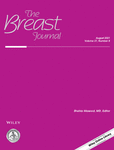HER-2/neu-positive breast cancer neoadjuvant chemotherapy response after implementation of 2018 ASCO/CAP focused update
Abstract
Human Epidermal Growth Factor Receptor 2 (HER2), a routinely tested breast cancer marker, is associated with worse prognosis yet increased sensitivity to targeted neoadjuvant therapy (NAT) in breast cancer patients. The presence of HER2 in breast carcinoma can be detected with either immunohistochemistry (IHC) or in situ hybridization (ISH). In this study, we examine the relationship between clinicopathological features, HER2 detection method (IHC vs ISH), and prognostic outcomes in NAT-treated HER2-positive breast cancer patients. We included 99 HER2-positive patients from three academic institutions following 2018 HER2 testing updates and conducted a retrospective correlational study. Seventy-one (72%) were HER2-positive by IHC and 28 (28%) were positive following reflexive ISH. Multivariate analysis showed biomarker status to be significantly associated with pathologic complete response (pCR) (p = 0.003), Residual Cancer Burden (RCB) (p = 0.007), and tumor size downstaging (p = 0.002) and HER2 detection method of IHC to be significantly associated with pCR (p = 0.05), RCB (p = 0.004), and nodal downstaging (p= 0.03). In conclusion, HER2 detection method and biomarker subtype allow for further prognostic stratification of HER2-positive patients when 2018 American Society of Clinical Oncology (ASCO)/College of American Pathologists (CAP) guideline updates are applied.
CONFLICT OF INTEREST
None of the authors have any conflicts of interest to disclose.




